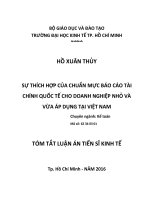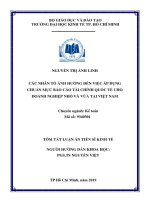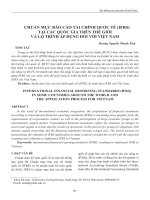Phương pháp giải đề thi và bài tập môn chuẩn mực báo cáo tài chính quốc tế 1
Bạn đang xem bản rút gọn của tài liệu. Xem và tải ngay bản đầy đủ của tài liệu tại đây (308.34 KB, 11 trang )
TRƯỜNG ĐẠI HỌC CƠNG NGHIỆP TP HCM
KHOA KẾ TỐN KIỂM TOÁN
--------
Số phách
KỲ THI GIỮA KỲ HỌC KỲ 1 NĂM HỌC 2020-2021
Môn: CMBCTCQT 1
Đề 1
Bậc: Đại học
Thời gian làm bài: ….. phút
(Sinh viên không được sử dụng tài liệu)
Số thứ tự
Họ tên và chữ ký cán bộ coi thi 1:
Họ tên và chữ ký cán bộ coi thi 2:
Họ tên sinh viên: …………………………………………………………………………
Mã số sinh viên: …………………………………………………………………………
Lớp học phần: ……………………………………………………………………………
ĐỀ THI GIỮA KỲ HỌC KỲ 2 NĂM HỌC 2020-2021
Môn: CMBCTCQT 1
Bậc: ĐẠI HỌC
Đề 1
Thời gian làm bài: 45 phút
(Sinh viên không được sử dụng tài liệu)
Số phách
Điểm kết luận của bài thi
Ghi bằng số
Giáo viên chấm 1
Câu 1: …………. điểm
Câu 2: …………. điểm
Câu 3: …………. điểm
Ghi bằng chữ
Họ tên và chữ ký
Giáo viên chấm 2
Câu 1: …………. điểm
Câu 2: …………. điểm
Câu 3: …………. điểm
Page 1 of 11
Họ tên và chữ ký
Tổng điểm: ………….
điểm
Tổng điểm: ………….
điểm
Question 1 (1 marks):
What is the difference between Periodic and Perpetual inventory system? Which companies usually use Periodic
inventory system and which companies usually use Perpetual inventory system?
Solution:
+ The difference between Periodic inventory system and Perpetual inventory system:
Perpetual inventory system
The cost of goods sold is already know.
Periodic inventory system
Require a calculation to determine the cost of
goods sold.
The cost of goods sold account will be updated The cost of goods sold is calculated at the end
when a sale is made.
of the accounting period.
Closing inventory = opening inventory + Cost of sales during the period = opening
purchase during the period – cost of sales inventory + purchase during the period –
during the period.
closing inventory (can only calculate at the end
of the accounting period).
+ Companies usually use periodic inventory system: Company business inventory have a low value, big
volume, different type such as material for sewing; small company don’t have the staff to work with perpetual
system, so they use periodic inventory system until the benefits of perpetual system bigger than the costs of
installing system; company don’t have many stocks to track.
+ Companies usually use perpetual inventory system: Huge company with multiple warehouses and large
amounts of inventory like car and machine, perpetual system can help owner company know which inventory is
selling with a high volume or low volume Can find ways to consume inventory, recover cost; small company
look to grow quickly also can use perpetual system to track inventory.
Question 2: (0.5 mark)
Page 2 of 11
Solution:
Page 3 of 11
Choose (C) FIFO or weighted average for the tires and specific identification for the golden wheels.
Explain:
-
-
The golden wheel is the material so the gold wheel is inventory. As on the fax, they planned to install
custom gold wheels on specific cars of their new range. From this, we can see that yellow wheels are not
mass produced or are often not interchangeable as each batch will have a different wheel design.
Following the IAS 02 inventories, the cost of inventories of items that are not ordinarily interchangeable
and goods or services produced and segregated for specific projects shall be assigned by using specific
identification of their individual costs.
Therefore, it is best to apply method of costing inventory for Gold wheel is Specific indentification.
Tires are raw materials, so tires are inventory. For tyres, apply the FIFO or weighted average cost
method. We see from the fax, they buy tires from suppliers in large quantities because they are imported
in large quantities, so if the FIFO method is applied, the inventory will be less obsolete, ensuring that
new goods are always updated. The cost of goods in stock is close to the market price, the inventory
indicator on the balance sheet is more economic.
Question 3: (2 marks)
a. If company uses FIFO, how much is the cost of sales? And how much is the closing inventory? (1 mark)
Solution:
DATE
Purchase
No,
Unit
Unit
cost
Cost of sale
Total
cost
No,
Unit
Unit cost
Balance
Total
cost
1/5/20X6
3/5/20X6
400
2.10
840
4/5/20X6
9/5/20X6
300
2.12
100
2.00
200
100
2.10
210
636
Page 4 of 11
No,
Unit
Unit
cost
Total
cost
100
2.00
200
100
2.00
200
400
2.10
840
300
2.10
630
300
2.10
630
11/5/20X6
18/5/20X6
100
2.40
300
2.10
630
100
2.12
212
240
20/5/20X6
100
2.12
212
31/5/20X6
300
2.12
636
200
2.12
424
200
2.12
424
100
2.40
240
100
2.12
212
100
2.40
240
100
2.12
212
100
2.40
240
Cost of sales = (100 x £2.00 + 100 x £2.10) + (300 x £2.10 + 100 x £2.12) + (100 x £2.12) = £1,464
Closing Inventory = (100 x £2.12) + (100 x £2.4) = £452
Including: 100 units is £2.12/unit
100 units is £2.40/unit
b. If company uses LIFO, how much is the cost of sales? And how much is the closing inventory? (1 mark)
Solution:
DATE
Purchase
No,
Unit
Unit
cost
Cost of sale
Total
cost
No,
Unit
Unit
cost
Balance
Total
cost
1/5/20X6
3/5/20X6
400
2.10
840
4/5/20X6
9/5/20X6
11/5/20X6
200
300
2.12
2.10
420
636
No,
Unit
Unit cost
Total
cost
100
2.00
200
100
2.00
200
400
2.10
840
100
2.00
200
200
2.10
420
100
2.00
200
200
2.10
420
300
2.12
636
300
2.12
636
100
2.00
200
100
2.10
210
100
2.10
210
Page 5 of 11
18/5/20X6
100
2.40
240
20/5/20X6
100
2.40
240
31/5/20X6
100
2.00
200
100
2.10
210
100
2.40
240
100
2.00
200
100
2.10
210
100
2.00
200
100
2.10
210
Cost of sales = (100 x £2.4 +100 x £2.12) + (200 x £2.12 + 200 x £2.1) + (100 x £2.1) = £1,506
Closing Inventory = (100 x £2.1) + (100 x £2.00) = £410
Including 100 units is £ 2.00/unit
100 units is £ 2.1/unit
Question 4 (1 mark)
a. The cost of inventory on hand at 1 January 2013 was $20,000 and at 31 December 2013 was $30,000.
Inventory purchases for the year amounted to $190,000, freight outwards expense was $1,000 and purchase
returns were $1,900. What was the cost of sales for the year ended 31 December 2013? (0.5 mark)
Solution
Calculate Ending Inventory Goods
Beginning Inventory + The debit incurred - The credit incurred = Ending Inventory
X
+
A
( B + 1,900)
= Y
=> B = X + A - Y
=> B = $20,000 + $190,000 - $35,000 - $1,900
Cost of sales = $20,000 + $190,000 - $35,000 - $1,900
= $178,100
Dr Cost of sales: $178,100
Cr Merchandise Inventory: $178,000
b. The following inventory information relates to K Rauma, who uses a periodic inventory system and rounds
the average unit cost to the nearest dollar:
Beginning inventory:
20 units
x
average cost of $30/unit
January purchase:
30 units
x
$32/unit
July purchase:
40 units
x
$36/unit
October purchase:
20 units
x
$24/unit
Page 6 of 11
Ending inventory
18
units
What is the cost of ending inventory using the weighted average costing method? (0.5 mark)
Solution
Beginning inventory = 20 units x $30/unit = $600
January purchase = 30 units x $32/unit = $960
July purchase = 40 units x $36/unit = $1,440
October purchase = 20 units x $24/unit = $480
Inventory =
= $31, 636/unit $32/unit
The cost of ending inventory = 18 units x $32
= $576
Question 5: (2 mark)
Malmo Ltd’s inventory transactions for April 2014 are shown below
Date
Purchase
No. of Unit cost Total
unit
cost
April 1
April 4
April 7
April 10
April 15
April 20
April 25
April
a. If Malmo
100
11
1,100
200
12
2,400
Cost of sales
No. of Unit cost Total
unit
cost
Balance
No. of Unit cost Total
unit
cost
30
10
300
110
120
(20)
150
13
1,950
(40)
13
(520)
Ltd uses the perpetual inventory system with the FIFO cost flow method, how much of closing
inventory? (1 mark)
Solution:
Date
No.
unit
April 1
April 4
April 7
100
Purchase
of Unit cost Total
cost
11.00
Cost of sales
of Unit cost Total
cost
No.
unit
1,100
30
80
10
11
Page 7 of 11
300
880
Balance
No. of Unit cost Total
unit
cost
30
10.00
300
30
10.00
300
100
11.00
1,100
20
11.00
220
April 10
200
12.00
2,400
April 15
20
100
(20)
April 20
April 25
150
13.00
1,950
April
(40)
13.00
(520)
11
12
12
220
1,200
(240)
20
200
11.00
12.00
220
2,400
100
120
120
150
120
110
12.00
12.00
12.00
13.00
12.00
13.00
1,200
1,440
1,440
1,950
1,440
1,430
The closing inventory is 230 units and total cost is $ 2,870.
b. If Malmo Ltd uses the perpetual inventory system with the moving average cost flow method, how much of
closing inventory? (1 mark)
Solution:
Date
No.
unit
Purchase
of Unit cost Total
cost
No.
unit
Cost of sales
of Unit cost Total
cost
April 1
April 4
100
11.00
1,100
April 7
110
10.77
1,184.7
April 10
200
12.00
2,400
April 15
120
11.89
1,426.8
April 20
(20)
11.89
(237.8)
April 25
150
13.00
1,950
April
(40)
13.00
(520)
The closing inventory is 230 units and total cost is $2,856.3.
Balance
No. of Unit cost Total
unit
cost
30
10.00
300
130
10.77
1,400
20
10.77
215.3
220
11.89
2,615.3
100
11.89
1,188.5
120
11.89
1,426.3
270
12.50
3,376.3
230
12.42
2,856.3
Question 6: (3 marks)
Taj Mahal Milling Co., a calendar-year entity, acquired a machine on June 1, 2013, that cost €100,000 with an
estimated useful life of four years and a €2,000 salvage value.
a. Calculate the depreciation expense for every year if company use straight-line method (1.5 mark)
Solution:
€24,500
01/06/2013
Year
Straight-line
2013 (7 month)
(24,500 : 12) x 7= €14,292
2014 (12 month)
€24,500
2015 (12 month)
€24,500
2016 (12 month)
€24,500
Page 8 of 11
2017 (5 month)
€24,500 - €14,292 = €10,208
Year 2013:
Dr Depreciation Expense: €14,292
Cr Accumulated Depreciation: €14,292
Year 2014
Dr Depreciation Expense: €24,500
Cr Accumulated Depreciation: €24,500
Year 2015:
Dr Depreciation Expense: €24,500
Cr Accumulated Depreciation: €24,500
Year 2016:
Dr Depreciation Expense: €24,500
Cr Accumulated Depreciation: €24,500
Year 2017
Dr Depreciation Expense: €10,208
Cr Accumulated Depreciation: €10,208
b. Calculate the depreciation expense for every year if company use double-declining balance method (1.5
mark)
Solution:
Double-declining balance
Depreciation = 2 × Straight-line rate × Carrying amount at beginning of year
01/01/2013
Year
Double-declining balance
2013 (12 months)
= 2 x 25% x 100,000= €50,000
2014 (12 months)
= 2 x 25%x(100,000 - 50,000) = €25,000
2015 (12 months)
= 2 x 25% x (100,000 - 50,000 - 25,000)= €12,500
2016 (12 months)
= 2 x 25% x (100,000 - 50,000 - 25,000 - 12,500)= €6,250
01/06/2013
Year
Double-declining balance
Page 9 of 11
2013 (7 months)
= (50,000 : 12) x 7 = €29,167
2014 (12 months)
5 months of 2013: 50,000 - 29,167 = €20,833
7 months of 2014: 25,000 : 12 x 7 = €14,583
2015 (12 months)
5 months of 2014: 25,000 - 14,583 = €10,417
7 months of 2015: 12,500 : 12 x 7 = €7,292
2016 (12 months)
5 months of 2015: 12,500 - 7,292 = €5,208
7 months of 2016: 6,250 : 12 x 7 = €3,646
2017 (5 months)
5 months of 2016: 6,250 - 3,646 = €2,604
Year 2013
Dr Depreciation Expenses: €29,167
Cr Accumulated Depreciation: €29,167
Year 2014
Dr Depreciation Expenses: €35,416
Cr Accumulated Depreciation: €35,416
Year 2015
Dr Depreciation Expenses: €17,709
Cr Accumulated Depreciation: €17,709
Year 2016
Dr Depreciation Expenses: €8,854
Cr Accumulated Depreciation: €8,854
Year 2017
Dr Depreciation Expenses: €2,604
Cr Accumulated Depreciation: €2,604
Question 7: (0.5 marks)
An asset with a cost of €400,000 was originally estimated to have a productive life of 20 years. The straight-line
method is used, and there was no residual value anticipated. After 6 years, management revises its estimate of
useful life to a total of 10 years.
Require: Calculate the depreciation after the useful life is changed (from year 7 to year 10)
Solution:
- Year 1: Depreciation
- Year 2: Depreciation = €20,000
- Year 3: Depreciation = €20,000
- Year 4: Depreciation = €20,000
- Year 5: Depreciation = €20,000
- Year 6: Depreciation = €20,000
- Year 7: Depreciation
- Year 8: Depreciation = €70,000
Page 10 of 11
-
Year 9: Depreciation = €70,000
Year 10: Depreciation = €70,000
Lưu ý: Sinh viên làm bài trực tiếp trên đề thi
--------------Hết-----------Duyệt đề thi
Page 11 of 11









